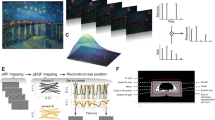Abstract
The representations of visual hemifields in the extrastriate areas of various species exhibit field discontinuities and islands. We propose that these violations of retinotopy are a developmental consequence of the elongated shape of the respective cortical areas. To substantiate this claim, we investigated a model of activity-driven map formation. In agreement with observations, this model yields maps with field discontinuities if the cortical areas exceed a threshold elongation. Moreover, within the same model island representations in the periphery and the area centralis can also be understood. A multistability of the solutions in the model gives a very simple explanation for the observed interindividual variability of maps in cats. The model leads to a prediction of the radial dependence of the areal magnification factor near field discontinuities, which could be accessible for a high precision mapping experiment.
Similar content being viewed by others
References
Albus K, Beckmann R (1980) Second and third visual areas of the cat: interindividual variability in retinotopic arrangement and cortical location. J Physiol 299:247–276
Allman JM, Kaas JH (1974) The organization of the second visual area (V2) in the owl monkey: a second order transformation of the visual hemifield. Brain Res 76:247–265
Durbin R, Mitchison G (1990) A dimension reduction framework for understanding cortical maps. Nature 343:644–647
Espinoza SG, Thomas HC (1983) Retinotopic organization of striate and extrastriate visual cortex in the hooded rat. Brain Res 272:137–144
Horton JC, Hoyt WF (1991) Quadrantic visual field defects. Brain 114:1703–1718
Hughes A (1977) The topography of vision in mammals of contrasting lifestyle: comparative optics and retinal organization. In: Handbook of sensory physiology VIII/5. Springer, Berlin Heidelberg New York, pp 613–756
Johnston A (1989) The geometry of the striate topographic map: functional implications. In: Cotterill RMJ (ed) Models of brain function. Cambridge University Press, Cambridge, UK, pp 211–230
Jones DG, Van Sluyters RC, Murphy KM (1991) A computational model for the overall pattern of ocular dominance. J Neurosci 11:3794–3808
Kaas JH (1982) A comparative survey of visual cortex organization in mammals. In: Ebbesson SOE (ed) Comparative neurology of the telencephalon. Plenum Press, New York, pp 483–501
Kohonen T (1989) Self-organization and associative memory, 3rd edn. Springer, Berlin Heidelberg New York
LeVay S, Connolly M, Houde J, Van Essen DC (1985) The complete pattern of ocular dominance stripes in the striate cortex and visual field of the macaque monkey. J Neurosci 5:486–501
Mallot HA (1985) An overall description of retinotopic mapping in the cat's visual cortex areas 17, 18 and 19. Biol Cybern 52:45–51
Mallot HA, Seelen W v, Giannakopoulos F (1990) Neural mapping and space-variant image processing. Neural Networks 3:245–263
Malsburg C von der (1973) Self-organization of orientation sensitive cells in the striate cortex. Kybernetik 14:85–100
Malsburg C von der (1979) Development of ocularity domains and growth behaviour of axon terminals. Biol Cybern 32:49–62
Miller KD, Keller JB, Stryker MP (1989) Ocular dominance column development: analysis and simulation. Science 245:605–615
Mitchison G, Durbin R (1986) Optimal numberings of an N × N array. SIAM J Alg Disc 7:571–581
Obermayer K, Ritter H, Schulten K (1990) A principle for the formation of the spatial structure of cortical feature maps. Proc Natl Acad Sci USA 87:8345–8349
Obermayer K, Blasdel CG, Schulten K (1992) Statistical-mechanical analysis of self-organization and pattern formation during the development of visual maps. Physiol Rev A 45:7568–7589
Orban G (1984) Neuronal operations in the visual cortex. Springer, Berlin Heidelberg New York
Rakic P (1988) Specification of cerebral cortical areas. Science 241:170–176
Ritter H, Schulten K (1986) On the stationary state of Kohonen's self-organizing sensory mapping. Biol Cybern 54:99–106
Ritter H, Schulten K (1988) Convergence properties of Kohonen's topology conserving maps: fluctuations, stability, and dimension selection. Biol Cybern 60:59–71
Ritter H, Martinetz T, Schulten K (1990) Neuronale Netze. Addison Wesley, Bonn
Schwartz EL (1980) Computational anatomy and functional architecture of striate cortex: a spatial mapping approach to perceptual coding. Vis Res 20:645–669
Tam S-S, Breen S (1993) Radial mosaicism and tangential cell dispersion both contribute to mouse neocortical development. Nature 362:638–640
Tusa RJ, Rosenquist AC, Palmer LA (1979) Retinotopic organization of areas 18 and 19 in the cat. J Comp Neurol 185:657–678
Wagor E, Mangini EJ, Perlman AL (1980) Retinotopic organization of triate and extrastriate visual cortex in the mouse. J Comp Neurol 193:187–202
Wässle H, Grünert U, Röhrenbeck J, Boycott BB (1989) Cortical magnification factor and the ganglion cell density of the primate retina. Nature 341:643–646
Author information
Authors and Affiliations
Rights and permissions
About this article
Cite this article
Wolf, F., Bauer, HU. & Geisel, T. Formation of field discontinuities and islands in visual cortical maps. Biol. Cybern. 70, 525–531 (1994). https://doi.org/10.1007/BF00198805
Received:
Accepted:
Issue Date:
DOI: https://doi.org/10.1007/BF00198805




